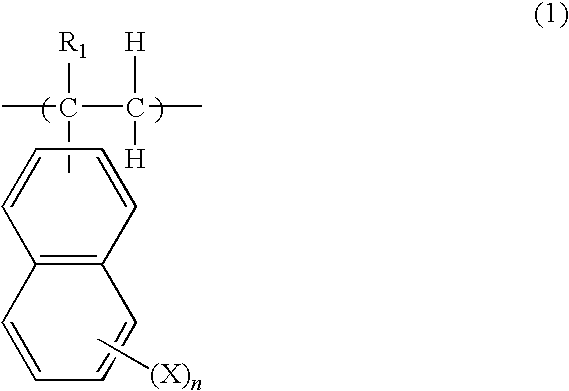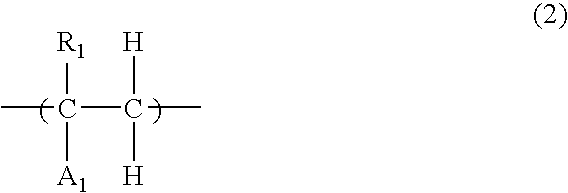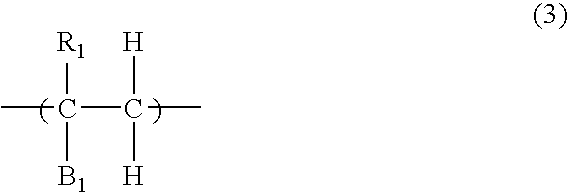Coating-type underlayer coating forming composition for lithography containing vinylnaphthalene resin derivative
a technology of vinylnaphthalene resin and coating type, applied in the direction of photosensitive materials, instruments, photomechanical equipment, etc., can solve the problems of affecting the effect of random reflection and standing wave of actinic rays on the substrate, and it is difficult to obtain a film thickness of resist pattern sufficient for substrate processing, so as to reduce the selection ratio and reduce the selection ratio of dry etching rate , the effect of preventing the collapse of resist pattern
- Summary
- Abstract
- Description
- Claims
- Application Information
AI Technical Summary
Benefits of technology
Problems solved by technology
Method used
Image
Examples
synthetic example 1
[0089]After 35 g (0.227 mol) of 2-vinylnaphthalene and 2.9 g (0.025 mol) of 2-hydroxyethyl acrylate were dissolved in 112 g of cyclohexanone in a flask, the atmosphere in the flask was substituted with nitrogen, and the temperature was raised to 60° C. After the completion of rise in temperature, 1.9 g of azobisisobutyronitrile dissolved in 47 g of cyclohexanone was added under pressure with nitrogen, and reacted with at 60° C. for 24 hours. The reacted solution was cooled and then added into methanol. Thereby a polymer was re-precipitated, and dried with heating to obtain the polymer of formula [5-1]. The resulting polymer had a weight average molecular weight Mw of 12000 (in terms of standard polystyrene).
synthetic example 2
[0090]After 10 g (0.065 mol) of 2-vinylnaphthalene and 23.0 g (0.097 mol) of 3-hydroxy-2-adamatyl methacrylate (manufactured by Maruzen Petrochemical, trade name: HAMA) were dissolved in 97 g of cyclohexanone in a flask, the atmosphere in the flask was substituted with nitrogen, and the temperature was raised to 60° C. After the completion of rise in temperature, 1.6 g of azobisisobutyronitrile dissolved in 41 g of cyclohexanone was added under pressure with nitrogen, and reacted with at 60° C. for 24 hours. The reacted solution was cooled and then added into methanol. Thereby a polymer was re-precipitated, and dried with heating to obtain the polymer of formula [5-2]. The resulting polymer had a weight average molecular weight Mw of 16000 (in terms of standard polystyrene).
synthetic example 3
[0091]After 30 g (0.195 mol) of 2-vinylnaphthalene and 3.1 g (0.022 mol) of glycidyl methacrylate were dissolved in 98 g of cyclohexanone in a flask, the atmosphere in the flask was substituted with nitrogen, and the temperature was raised to 60° C. After the completion of rise in temperature, 1.7 g of azobisisobutyronitrile dissolved in 41 g of cyclohexanone was added under pressure with nitrogen, and reacted with at 60° C. for 24 hours. The reacted solution was cooled and then added into methanol. Thereby a polymer was re-precipitated, and dried with heating to obtain the polymer of formula [5-3]. The resulting polymer had a weight average molecular weight Mw of 10000 (in terms of standard polystyrene).
[0092]After 15 g of the polymer of formula [5-3] and 2.0 g (0.009 mol) of 9-anthracene carboxylic acid were dissolved in 68 g of cyclohexanone, 0.05 g of benzyltriethyl ammonium chloride was added, and reacted with at 130° C. for 24 hours to obtain a solution containing the polymer ...
PUM
| Property | Measurement | Unit |
|---|---|---|
| molar ratio | aaaaa | aaaaa |
| molar ratio | aaaaa | aaaaa |
| molar ratio | aaaaa | aaaaa |
Abstract
Description
Claims
Application Information
 Login to View More
Login to View More - R&D
- Intellectual Property
- Life Sciences
- Materials
- Tech Scout
- Unparalleled Data Quality
- Higher Quality Content
- 60% Fewer Hallucinations
Browse by: Latest US Patents, China's latest patents, Technical Efficacy Thesaurus, Application Domain, Technology Topic, Popular Technical Reports.
© 2025 PatSnap. All rights reserved.Legal|Privacy policy|Modern Slavery Act Transparency Statement|Sitemap|About US| Contact US: help@patsnap.com



